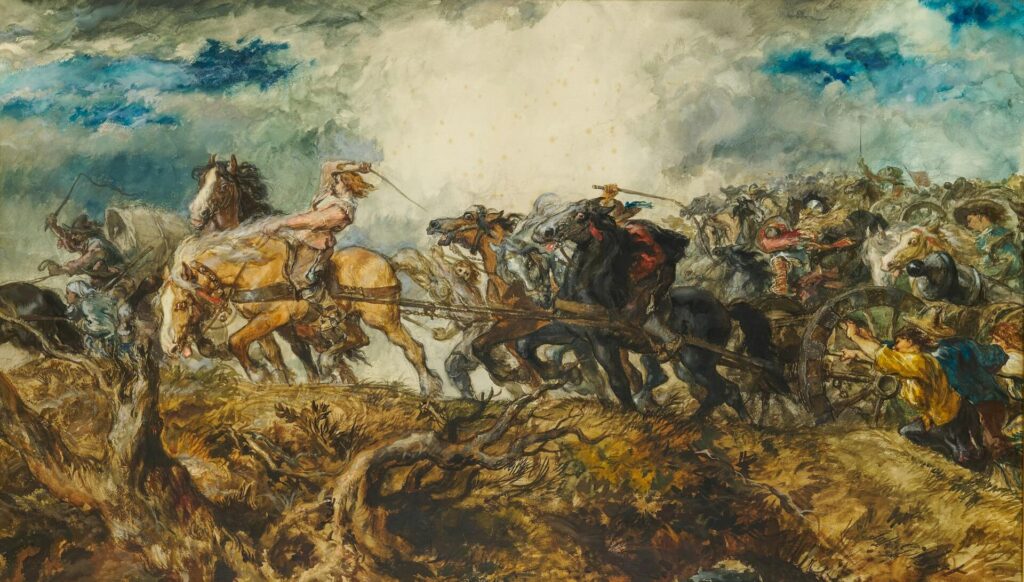Art isn’t just a collection of pretty pictures. It’s a mirror that reflects the values, beliefs, and aesthetic preferences of a society at a specific point in time. Understanding the evolution of art means taking a deep look into the cultural heritage of humanity.
In this extensive exploration of the topic, we’ll travel through various historical periods and explore one iconic artwork from each era that is emblematic of its time.
Prepare for a time travel through canvases that will not just inspire your creative soul but also ensure you grasp the context and significance of art through the ages.
The Dawn of Art: Prehistoric Times
Even before recorded history, our ancestors were already artists. The very first cave paintings, such as those found in the Lascaux and Chauvet caves in France, are not only some of the oldest but also amongst the most famous.
They provide a window into a world of hunting and spirituality, capturing the essence of the Paleolithic period and the life of early humans. These paintings of large animals, often dating back over 30,000 years, introduce us to a society that was deeply connected to the natural world and that expressed this relationship through complex and beautiful artworks.
Lascaux Cave Paintings
The animal figures, such as bulls, horses, and deer, painted in black and red ochre, are not mere representations but invoke a sense of time, space, and the spiritual relationship between humans and the animal kingdom.
These paintings likely served ritualistic or ceremonial functions, indicating the sophisticated symbolic language of the prehistoric mind.
Ancient Art:
We next move on to the art of the ancient civilizations, which laid the foundations for Western art. From the great palaces and temples of Mesopotamia to the exquisite artifacts of the Egyptians, art became a sign of empire, divinity, and human achievement.
Complex and often hierarchical societies flourished, giving rise to works reflecting mathematic precision, divine order, and human ambition, creating faithful records of their civilization’s beliefs and customs.
The Pyramids at Giza
Standing as a testament to the ancient Egyptians’ immense cultural, religious, and artistic capabilities, the Pyramids at Giza remain one of the most celebrated wonders of the world.
Built as tombs for the pharaohs and the entrance into the afterlife, the scale and precision of these architectural marvels continue to awe and inspire.
The Great Pyramid of Giza, built for the Pharaoh Khufu, was the tallest man-made structure for over 3,800 years, telling us much about the capacity and aspirations of ancient Egyptian society.
Classical Antiquity:
The Greeks and the Romans defined what we know as Classical art, celebrating the human form and developing artistic principles that would endure for millennia.
The Greeks, with their idealized sculptures, and the Romans, with their vast architectural projects, left a legacy that still influences the aesthetics of the modern world.
During this time, art began to shift from merely reflecting divinity and styling human achievements to a focus on human proportions and natural beauty, as well as narrative elements.
The Discobolus of Myron
This sculpture from ancient Greece, depicting a discus thrower, is a precursor to the Renaissance ideal of human proportion and form.
Created by the sculptor Myron, it captures a moment in time with an unparalleled understanding of human anatomy and movement. This masterpiece reflects the Greek belief in physical perfection and the importance of athletics in their society.
Medieval Period:
The fall of the Roman Empire plunged Europe into the Middle Ages, a time often considered a ‘dark’ age, but one that also established the roots of modern Western culture.
Art in this period was dominated by the Christian Church, with its architecture, sculpture, and painting serving symbolic and didactic purposes, such as instructing the largely illiterate populace in the precepts of the faith.
The Book of Kells
This illuminated manuscript from around the early 9th century is an epitome of the intricate and colorful abstract forms found in Celtic art. Created in a Columban monastery, probably on the island of Iona in Scotland, the book contains the four Gospels, an analysis of the authenticity of its theology and illumination.
The Book of Kells stands as a masterpiece of devotion and craftsmanship in an era where faith and art were intricately entwined.
The Renaissance:
The Renaissance, a period of renewed interest in classical learning and the arts, saw a remarkable flowering of creativity across Europe.
This was an era of scientific discovery, geographic exploration, and the individual’s supposed mastery over nature. Artists like Da Vinci, Michelangelo, and Raphael created works that have become synonymous with the period’s pursuit of knowledge and beauty.
Leonardo da Vinci’s ‘Mona Lisa’
Arguably the most famous painting in the world, the ‘Mona Lisa’ encapsulates the Renaissance artist’s intricate understanding of light, shade, and human emotion. Leonardo da Vinci’s enigmatic portrait is a subtle celebration of the individual, as well as a study in naturalism and landscape. The piece has come to embody the Renaissance’s focus on the individual’s intellect and dignity.
The Baroque Period:
The Baroque was a time of stirring emotions and subjective interpretation in Europe, characterized by exuberance, drama, and dynamic compositions. It was a time of scientific revolution, expanding empires, and the rise of the middle class, and art aimed to overwhelm and stir the senses.
Caravaggio’s ‘The Calling of Saint Matthew’
Caravaggio’s revolutionary use of lighting and his gritty realism made him a pivotal figure in Baroque art. ‘The Calling of Saint Matthew’ is a powerful depiction of a momentous event in the life of one of the Church’s central figures.
Caravaggio’s work captures human fragility and the divine’s unanticipated arrival, a theme that resonates in an era of religious and cultural upheaval.
The Enlightenment and Neoclassicism:
The Enlightenment brought a new focus on reason, science, and the value of individuals, leading to a Neoclassical revival of ancient Greek and Roman art in the 18th and 19th centuries. Art of this period sought to make moral and political statements, often through grand scenes and historical subjects.
Jacques-Louis David’s ‘The Oath of the Horatii’
A defining masterpiece of Neoclassical art, this painting by David tells the story of Roman honor and sacrifice, themes that resonated strongly with the French Revolution’s calls for patriotism.
Its clear, balanced composition and severe, sculpted figures are a visual representation of the period’s intellectual and moral aspirations.
Romanticism:
Reacting against the rationalism and restraint of the Neoclassical era, the Romantic period celebrated emotion, nature, and the exotic. Romantic artists sought to create a more personal and free expression in their work, often turning to landscapes and scenes from distant times and places.
Eugène Delacroix’s ‘Liberty Leading the People’
This iconic painting, which captures the spirit of the 1830 Revolution in France, is a quintessential work of the Romantic period.
Depicting Liberty with the tricolor flag leading a diverse mix of fighters, ‘Liberty Leading the People’ is a passionate embodiment of the period’s revolutionary fervor and the power of the collective spirit.
Impressionism:
The Impressionists sought to capture the fleeting effects of light and color by painting quickly and directly from nature, giving rise to a new way of seeing and representing the world.
Their open-air painting techniques and emphasis on the moment had a profound influence on the trajectory of modern art.
Claude Monet’s ‘Impression, Sunrise’
Monet’s painting ‘Impression, Sunrise’ not only lent its name to the Impressionist movement but also epitomized its emphasis on capturing ephemeral and sensory experiences.
Here, Monet’s loose brushwork and focus on the atmospheric conditions create an artwork less concerned with historical or moral narratives, but instead with the poetic beauty of light and form.
Modernism:
Characterized by a break with the past and an eagerness to experiment with new forms, Modernism was a response to the rapidly changing world of the late 19th and early 20th centuries.
Artists during this period, from Pablo Picasso to Wassily Kandinsky, pushed the boundaries of what art could be, exploring ideas rather than simply representing the world.
Pablo Picasso’s ‘Les Demoiselles d’Avignon’
Picasso’s groundbreaking work signaled the dawn of Cubism and the beginning of a new epoch in art. Departing from traditional forms, ‘Les Demoiselles d’Avignon’ shocked the art world with its geometric fragmentation of the human figure.
This painting is a powerful statement on the state of modernity, cultural transformation, and the human psyche.
Postmodern Art:
Emerging after World War II and continuing to the present day, Postmodern art is characterized by its rejection of grand narratives, irony, and an emphasis on pastiche and the deconstruction of cultural conventions.
It is an era that’s seen a rise in conceptual art, performance art, and a wide array of media that explores and often questions the nature of art itself.
Banksy’s ‘Girl with a Red Balloon’
Banksy, the anonymous British street artist, created ‘Girl with a Red Balloon’ in 2002 as a symbol of hope and resistance.
The image of a young girl reaching for a heart-shaped balloon has become one of Banksy’s most iconic works, appreciated for its simplicity and powerful message in an age of cultural and political skepticism.
In recent years, drone photography and videography have revolutionized the creative industries, offering a fresh perspective that captures the world from breathtaking heights.
As a pivotal aspect of modern visual storytelling, this technology has become instrumental in defining contemporary art and film-making. Its ability to provide aerial views has not only enhanced the aesthetic appeal of visual content but also allowed for innovative approaches to capturing the essence of landscapes, architectural marvels, and natural phenomena.
This transformation underscores a significant period in the evolution of media and art, showcasing how technological advancements continually shape and redefine the creative canvas.
Each of these periods, and the masterpieces that defined them, offer a rich tapestry of human expression and experience. By understanding the historical, cultural, and philosophical contexts in which art is created, we not only deepen our appreciation for these works but also our understanding of our collective human story.
Art through the ages is a mirror in which we can see our aspirations, our fears, and our enduring creativity reflected back at us, and it is a legacy that continues to inspire and challenge us today.










